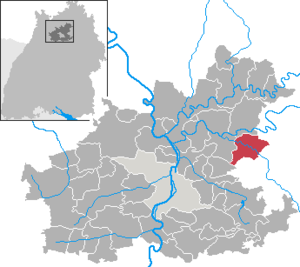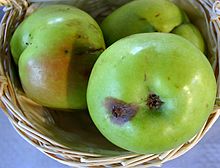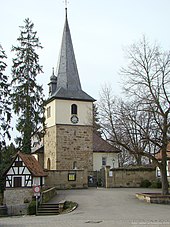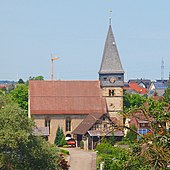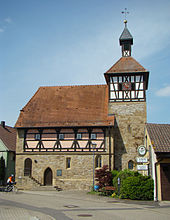Langenbrettach
| coat of arms | Germany map | |
|---|---|---|

|
Coordinates: 49 ° 14 ' N , 9 ° 23' E |
|
| Basic data | ||
| State : | Baden-Württemberg | |
| Administrative region : | Stuttgart | |
| County : | Heilbronn | |
| Height : | 194 m above sea level NHN | |
| Area : | 23.97 km 2 | |
| Residents: | 3848 (Dec. 31, 2018) | |
| Population density : | 161 inhabitants per km 2 | |
| Postal code : | 74243 | |
| Primaries : | 07139, 07946 | |
| License plate : | HN | |
| Community key : | 08 1 25 113 | |
| LOCODE : | DE LTC | |
| Community structure: | 3 districts | |
| Address of the municipal administration: |
Rathausstrasse 1 74243 Langenbrettach |
|
| Website : | ||
| Mayor : | Timo Natter | |
| Location of the municipality of Langenbrettach in the Heilbronn district | ||
Langenbrettach is a municipality in the district of Heilbronn in Baden-Württemberg , which was created on January 1, 1975 through the merger of Brettach and Langenbeutingen to form the new municipality of Brettach-Langenbeutingen and was renamed Langenbrettach on July 1, 1976 . It belongs to the Heilbronn-Franconia region (until May 20, 2003 Franconia region ).
geography
Geographical location
Langenbrettach is located in the east of the Heilbronn district at heights between a little below 170 to almost 340 m above sea level. NN . The community has a share in the natural areas of Hohenloher-Haller Ebene and Swabian-Franconian Forest Mountains .
The municipality is traversed in a west-northwest direction by the lower Brettach , a Kocher tributary that also drains most of the water. The small Riedbach emerging in the northeast and flowing parallel to it is itself a tributary of the Kocher. The (Cleversulzbacher) Sulzbach rises in a forest ridge in the southwest, and it only reaches the Brettach below the community.
The Brettach, which is 194.3 m above sea level , forms on the parish of the municipality . NN reaches their area and it is a little below 169.8 m above sea level. NN again leaves, in a flat valley basin rich meadow meanders , at the right foot of the slope or on the right slope lie one after the other the only large settlements Langenbeutingen and Brettach. Between the two they reach their locally largest tributaries in close succession, first the Seebächle and Landgraben from the right, then the longer Tabach from the left. The majority of the community area is in open corridors, the far east is covered by the approximately 1 km² forest Zuckmantel, in the southwest Langenbrettach around the headwaters of the Tabach has over 5 km² in a mountain forest area that continues far beyond the border to the south and west, here is also the one with 338.4 m above sea level. NN highest point of the municipality.
Neighboring communities
The neighboring communities of Langenbrettach are (clockwise, starting in the east): City of Öhringen , Bretzfeld (both Hohenlohekreis ), Eberstadt , City of Neuenstadt am Kocher and Hardthausen am Kocher (all district of Heilbronn). Langenbrettach has entered into an agreed administrative partnership with Neuenstadt am Kocher and Hardthausen am Kocher .
Community structure
Langenbrettach consists of the suburbs Brettach and Langenbeutingen. The hamlet of Neudeck and the Wiesenhof farm also belong to Langenbeutingen . Places that have passed and no longer exist today are on Brettach Odeldingen and Schleifmühle, on Langenbeutingen Betbunt, Hewsterhofen, Rymelauwe, Undernhofen and Waltersfurt.
Division of space

According to data from the State Statistical Office , as of 2014.
history
Brettach
The oldest traces of settlement in Brettach date to 360 BC. An Alemannic settlement called Odoldinga is believed to have been in AD 350. Around 500 the Franks founded the settlement Brettach (from broad aha , broad Au) west of Odoldinga . The place, first mentioned in a document about Heinrich von Brettach in 1261, belonged to the Lords of Weinsberg from 1366 , was pledged several times and was finally owned by the Electoral Palatinate , which lost it to Württemberg in the Landshut War of Succession in 1504 . In the Thirty Years' War Brettach was repeated by mercenaries occupied, looted and burned. In 1635 the plague raged . The place belonged to the Oberamt Neckarsulm , which later became part of the Heilbronn district. In 1933 there were 994 inhabitants, in 1939 there were 921 and at the end of 1945 there were 1023.
Langenbeutingen
The first traces of settlement can be found for Langenbeutingen around 1000 BC. Prove. The place was first mentioned in a document in 855 in the Lorsch Codex as Butinga . In the high Middle Ages, the place was largely owned by the Lords of Neudeck , who owned Neudeck Castle in Neudeck, southeast of Beutingen . With most of the Neudeck property, the place came to Hohenlohe in the 14th and 15th centuries . As recently as the 15th century, a distinction was made between Ober-Beutingen and Unter-Beutingen , with the lower town being the original Beutingen and the upper town also being called Weyer (Wyer / Weyher) . The coalescence of the two districts up to around 1600 resulted in today's elongated settlement form of the place, whose two historical churches still show the historical settlement centers. Hohenlohe was part of the Franconian Empire between 1500 and 1806 . In 1806, Beutingen became part of Württemberg and was given its current name Langenbeutingen by the Württemberg people. From 1809 it belonged to the Oberamt and from 1938 to the district of Öhringen . In 1933 there were 797 inhabitants, in 1939 there were 764 and at the end of 1945 there were 941. In 1956 the Wiesenhof residential area was mentioned for the first time in Langenbeutingen. 1973 Langenbeutingen joined the Heilbronn district, to which Brettach also belonged.
Langenbrettach
On January 1, 1975, Brettach and Langenbeutingen were merged to form the new municipality of Brettach-Langenbeutingen. On July 1, 1976, it was renamed Langenbrettach.
Religions
In 1534 the Reformation was introduced in Württemberg and thus also in Brettach . Today the residents of Langenbrettach are predominantly Protestant. In Brettach and Langenbeutingen there is a separate Protestant parish, whereby the Protestant parish Brettach belongs to the Weinstadt-Neuenstadt church district of the Evangelical State Church in Württemberg and the Langenbeutingen Protestant church belongs to the Öhringen church district . The Martinskirche in Langenbeutingen is the original church of the Brettachgau . There is an old Pietist community in the Brettach community .
The New Apostolic parish in the neighboring town of Neuenstadt am Kocher, which is also responsible for Langenbrettach, has its origins in Brettach.
politics
Municipal council
In Langenbrettach, the municipal council is elected using the spurious selection process . The number of local councils can change due to overhang mandates . The municipal council in Langenbrettach has 15 members after the last election (2014: 15). The local elections on May 26, 2019 led to the following official final result: the turnout was 62.9% (2014: 49.9%). The municipal council consists of the elected voluntary councilors and the mayor as chairman. The mayor is entitled to vote in the municipal council.
| Free electoral association | 12 seats | 79.9% | (2014: 12 seats, 79.8%) |
| Independent list of women | 3 seats | 20.1% | (2014: 3 seats, 20.2%) |
In the village of Langenbeutingen there is a local council with eight members (7 Langenbeutingen, 1 Neudeck) to be elected by the eligible population at every local election . At his suggestion, the municipal council elects the honorary mayor of Langenbeutingen. The local council and mayor are to be heard on important matters affecting the locality.
mayor
Timo Natter has been the mayor of the municipality since August 2011. On June 30, 2019, he was re-elected with 58.69% of the vote (2011: 95%).
badges and flags
| Coat of arms of Langenbrettach | |
| Blazon : "In blue a silver wave sloping left bar, above a golden apple with a left-pointing golden leaf (Brettach apple), below a golden church with a tower on the left." | |
| Justification for the coat of arms: The apple symbolizes the Brettacher , an apple variety that was discovered in 1911 as a chance seedling in Brettach and was widespread in the middle of the 20th century. The church was taken over from the Langenbeutinger coat of arms; the oblique left-hand bar symbolizes the Brettach , which flows close to all three districts of the community. |
The flag of the municipality is yellow-blue. The coat of arms and flag were awarded to the community on April 26, 1976 by the district office of Heilbronn.
| Brettach coat of arms | |
| Blazon : "A golden panicle of oats in blue." | |
| Justification of the coat of arms: The oldest known Brettach seal from 1630 shows a man as a coat of arms figure who holds an outwardly turned sickle in his right hand and a grain fruit in his left. All of the later seals that have been preserved only show a panicle of oats in the coat of arms. There are two explanations for the depiction of the oat panicle: On the one hand, it can be understood as a symbol for the fertile loess soil of the Brettach district, on which mainly oats, at that time the most important grain variety, were grown at the time the coat of arms was created (also stated in the description of the Neckarsulm District Office from 1881). On the other hand, it is possibly a symbol of the French monk St. Aegidius , who Christianized the place. |
The coat of arms colors were determined in 1918 by the Württemberg archives. The Baden-Württemberg Ministry of the Interior confirmed the coat of arms on April 20, 1964 and awarded the community of Brettach the yellow-blue flag.
| Coat of arms of Langenbeutingen | |
| Blazon : "In blue a silver waved oblique left-hand bar, accompanied on both sides by a silver church." | |
| Justification of the coat of arms: The two churches remind us that Langenbeutingen emerged from two hamlets that grew together, originally separated by a stream, and that as a result, it has two church buildings. |
The coat of arms was adopted in 1914.
Neudeck itself does not have its own coat of arms; however, it was ruled for several centuries in the Middle Ages by the Lords of Neudeck , whose coat of arms shows a red crossbar on a silver background.
Culture and sights
Worth seeing in Brettach
- The Egidius Church , mentioned for the first time in 1264, is a former fortified church that was surrounded by a moat and 23 so-called Gaden in the Middle Ages . The oldest parts of the church are probably from the late 10th century. The church goes back to a very old, probably Alemannic place of worship at a spring. Probably in the late 10th century it was expanded into a walled fortified church with a moat. In addition to the church, the complex once comprised 23 so-called gaden , which were used as fruit storage sheds with vaulted cellars, but also as places of refuge for the population within the weir system. The portal from 1514, which was moved to the new west wall in 1578 and an inscription on the nave that names the builder Clemens Vock for this year, testify to the expansion of the church in the 16th century . Above all, it was about the considerable expansion (area quadrupling) of the nave to the north and west in the sense of a transverse church with installation first of the west, and in 1681 also the north gallery (including the eastern leg on the front wall up to the choir arch) and alignment of the Church stalls to the pulpit in front of the south wall (moved as a low ambo to the arched wall in 1955 ). Around 1570 the weir ditch was also filled in and the spring, which faces the church fountain, was covered with a vault, creating the Lindenplatz in front of the church. The already dilapidated Gaden was demolished in 1578. Today only one Gaden remains, which was still used as a community prison in the 19th century. In 1886 Heinrich Dolmetsch renovated the church, the interior was renewed again in 1955 by Hannes Mayer , whereby the respective character of the early Romanesque choir and the Renaissance nave were restored. The interior of the church has preserved renaissance wall paintings: by David Ebermann from Heilbronn in 1591 the north wall painting depicting Luther with a swan , probably the oldest Luther painting in Württemberg, and by Hans Veit Becker from Heilbronn in 1681 the wall paintings from Isaac's sacrifice to the new Jerusalem. The historical furnishings also include more than 20 paintings in the balustrade of the galleries with depictions from the Old and New Testament, the high baroque age of the apostles from 1681 including a crucifix with evangelist medallions on the four arms of the cross, the pulpit, the historic organ prospect from 1762, two Angel figures in the tower base and an epitaph with kneeling donors in front of the risen Christ on the choir wall. The glass painter Adolf Valentin Saile contributed to the renovation in 1955 with the depiction of Peter, Paul and Christ the ruler of the world in the choir window.
- On the outside of the church there are two war memorials for the local fallen of both world wars (the second is by Helmuth Uhrig ), in the surrounding cemetery there is the large copper beech planted around 1840 . The nearby rectory was built in 1740.
- The Lindenplatz was extended in the 19th century m through the expansion of the vault above the Kirchbrunnen to a total length of 17th A Renaissance portal with a fragment of a wall in front of a half-timbered house from 1580 has been preserved on Lindenplatz.
- The Gasthaus Lamm in the center of the village has a historical portal with a coat of arms from 1601. A few other buildings in the center of the village also have decorated historical portals.
- The Chanowskysche Schlösschen was built around 1609/10 by Junker Heinrich Chanowsky , herzogl. Württ. Forester in Neuenstadt am Kocher, built in the Mannerist style. The building with the distinctive volute gable was acquired in 1664 by Duke Friedrich von Württemberg-Neustadt , who in 1649 was given the offices of Neuenstadt, Möckmühl and Weinsberg to supply it. The castle had been privately owned since the 18th century. Since August 2012 it has been owned by the municipality of Langenbrettach, which, after extensive renovation, has been using it as an administrative building under the name Chanofsky-Schlössle since October 2015 . It is decorated with the magnificent coat of arms of the Chanowsky (around 1600).
- On the Brettach is the restored Brettach mill from the 17th century with another ornate volute gable. Near the mill, a small stone bridge from 1730 leads over the mill ditch branched off from the Brettach .
- Other distinctive historical buildings in Brettach include the old schoolhouse from 1872 and the town hall from 1888.
Sights in Langenbeutingen
- Martinskirche
The Martinskirche (also Upper Church ) has been documented as a parish church since the early 14th century. The church is said to be a Merovingian foundation and is considered the early church of the Brettachgau. The nave of the Romanesque choir tower was rebuilt in 1609/10 and later renovated several times. The roof gable was temporarily used as a granary. The most important furnishings of the church (crucifix, angel, altar, pulpit, baptismal font) date from the 18th and 19th centuries.
- Lower church
The lower church was first mentioned in 1534. The probably older building was redesigned in the late Gothic style in 1512, heightened with Alemannic half-timbering in 1627 and completed with a Franconian half-timbered tower in 1830. In the attic was the home club History 2004, the Albrecht-Goes-room a small literary memorial for the Hohenlohe pastor and poet set, Albrecht Goes (1908-2000). In addition to editions of his works, furniture from his property is also shown.
Hungerlinde Langenbeutingen
The "Hungerlinde" ⊙ called Tanzlinde stands in the western part of the old village, directly at the "Unteren Kirchle". It was planted in memory of the hunger winter of 1817 and raised as a guided linden tree to become a dancing linden tree . The form of a walk-in arbor with a flat canopy was chosen for this, by fixing the lower main branches in a wreath-like manner on supports for horizontal growth. This resulted in a broad crown formation with dense foliage.
The evenly shaped winter linden tree, which was included in the list of distinctive and old tree specimens , has now been designated as a natural monument and is still a place for social occasions and celebrations. In the meantime it has reached an age of just over 200 years and has developed a trunk circumference of approx. 2.5 m. Due to its umbrella-like, expansive crown structure, it comes to a comparatively low height of 15 m.
Regular events
- Brettacher Markt: In 1681 Brettach was granted market rights . Since then, the Brettach Market has been held there every year, currently on the fourth Sunday and the previous Saturday in September. The two-day event includes a grocer's market with around 170 stalls from all over Baden-Württemberg, numerous information and food stalls from local associations and an amusement park .
Economy and Infrastructure
Agriculture
The district of Langenbeutingen is a wine-growing area, the locations of which are part of the large Lindelberg site in the Württemberg lowlands of the Württemberg wine-growing region .
traffic
Langenbrettach can be reached on trunk roads via the A 81 ( Stuttgart - Würzburg ), exit 8 ( Neuenstadt am Kocher ) and then the L 1088 towards Öhringen. The community can also be reached via the A 6 ( Mannheim - Nuremberg ), exit 40 ( Öhringen ), then using the L 1088 in the direction of Neuenstadt.
To the public transport Langenbrettach is Heilbronn or Neckarsulm via the HNV -Regionalbuslinien 620, 624 and 625 connected towards another city. In Neuenstadt ( Lindenplatz bus station ) you have to change to line 623 in the direction of Neudeck or Langenbeutingen. The buses run at least every hour from Monday to Friday, and every half hour during rush hour; however, on weekends the timetable is considerably restricted. In addition, there is a bus connection from Öhringen train station via line 49 in the direction of Brettach, Kochersteinsfeld or Neuenstadt, which is also served quite irregularly on weekdays.
media
The daily newspaper Heilbronner Voice reports on the events in Langenbrettach in its edition N, District North.
Public facilities
In Langenbeutingen, the community operates an unheated public outdoor pool that is open from May to September. Facilities include a swimmer's pool (lane length: 33.33 m) with a one-meter and three-meter diving board, a non-swimmer pool with a water slide and a paddling pool for small children. A special feature of this pool is the so-called underwater view: Since the swimmer's pool is not set into the ground for flood protection reasons, but is built up high, it is possible to look at the bathers below the water line through two viewing windows in the pool wall, as in an aquarium .
education
In Langenbrettach there is a primary school with school buildings in Langenbeutingen and Brettach. In addition, the Unterland Adult Education Center in Langenbrettach has a branch.
Personalities
Sons and daughters of the church
- Reinhard Köstlin (born April 11, 1875 in Langenbeutingen; † January 31, 1957 in Schwarzenberg-Schönmünzach), administrative lawyer, President of the Württemberg State Ministry.
- Karl Simpfendörfer (born September 2, 1906 in Brettach; † December 25, 1984 in Bad Friedrichshall), politician (DVP, CDU), Member of the Bundestag
- Albrecht Goes (born March 22, 1908 in Langenbeutingen; † February 23, 2000 in Stuttgart), writer and Protestant theologian
Personalities who have worked or are working in the place
- Philipp Friedrich Hiller (born January 6, 1699 in Mühlhausen an der Enz, † April 24, 1769 in Steinheim am Albuch), Protestant pastor and hymn poet
- Julius von Jan (born April 17, 1897 in Schweindorf / Württemberg; † September 21, 1964 in Korntal), Protestant pastor and resistance fighter
- Jörg Sommer (born August 1, 1963 in Heilbronn), children's and young adult book author, lived and worked in Langenbeutingen
Individual evidence
- ↑ State Statistical Office Baden-Württemberg - Population by nationality and gender on December 31, 2018 (CSV file) ( help on this ).
- ↑ Natural areas of Baden-Württemberg . State Institute for the Environment, Measurements and Nature Conservation Baden-Württemberg, Stuttgart 2010 ( PDF file 3.18 MB)
- ↑ Topographic map 1: 25,000 Baden-Württemberg North, in single sheet cut No. 6722 and 6822
- ^ Source for the section on community structure: Das Land Baden-Württemberg. Official description by district and municipality. Volume IV: Stuttgart district, Franconian and East Württemberg regional associations. Kohlhammer, Stuttgart 1980, ISBN 3-17-005708-1 , pp. 129-131.
- ↑ State Statistical Office, area since 1988 according to actual use for Langenbrettach.
- ↑ a b Communications from the Württemberg Stat. State Office No. 4/5 of December 10, 1940: Results of the population and occupational census on May 17, 1939.
- ^ A b Results of the population census and determination of residence on December 4, 1945 in Northern Württemberg.
- ^ Minst, Karl Josef [transl.]: Lorscher Codex (Volume 5), Certificate 3618, October 24, 855 - Reg. 3386. In: Heidelberger historical stocks - digital. Heidelberg University Library, p. 229 , accessed on January 19, 2018 .
- ^ Description of the Oberamt Oehringen , Stuttgart 1865, p. 258, p. 262ff.
- ↑ https://www.leo-bw.de/web/guest/detail-gis/-/Detail/details/ORT/labw_ortslexikon/2344/Wiesenhof+-+Wohnplatz
- ^ Federal Statistical Office (ed.): Historical municipality directory for the Federal Republic of Germany. Name, border and key number changes in municipalities, counties and administrative districts from May 27, 1970 to December 31, 1982 . W. Kohlhammer, Stuttgart / Mainz 1983, ISBN 3-17-003263-1 , p. 465 .
- ^ Website of the Evangelical Church Community in Brettach
- ^ Website of the Evangelical Church District Weinsberg-Neuenstadt
- ↑ Website of the Evangelical Church Community Langenbeutingen
- ↑ https://www.statistik-bw.de/Wahlen/Kommunal/02045000.tab?R=GS125113
- ↑ https://www.langenbrettach.de/fileadmin/Dateien/Dateien/Wahlen/Erresult_Gemeinderat.pdf
- ↑ https://www.staatsanzeiger.de/staatsanzeiger/wahlen/buergermeisterwahlen/langenbrettach/
- ↑ http://www.stimme.de/heilbronn/nachrichten/region/sonstige-Timo-Natter-mit-95-Prozent-zum-neuen-Buergermeister-gewaehlt;art16305,2209327
- ^ Herbert Schlegel and Eugen Schumacher: Langenbrettach: The past in pictures . Verlag Friedrichshaller Rundblick, Langenbrettach 1990, ISBN 3-9802222-1-7 , p. 5.
-
↑ Further sources for the section coat of arms and flag:
Heinz Bardua: The district and community coat of arms in the administrative district of Stuttgart . Theiss, Stuttgart 1987, ISBN 3-8062-0801-8 (district and community arms in Baden-Württemberg, 1), p. 90.
Eberhard Gönner: Book of arms of the city and district of Heilbronn with a territorial history of this area . Archive Directorate Stuttgart, Stuttgart 1965 (Publications of the State Archive Administration Baden-Württemberg, 9), p. 64.
The district of Öhringen. Official district description . Volume II. State Archive Administration Baden-Württemberg, [Stuttgart] 1968, p. 296. - ↑ Evangelical parishes of the district of Neuenstadt am Kocher (ed.): Our home, the church. Home book of the district of Neuenstadt am Kocher. Pictures from the Neuenstadt district. Stuttgart 1959, p. 33 f
- ^ Evangelical Church in Brettach - Discoveries in the year of the 500th anniversary of the Reformation ; Published by Evangelical Church Community of Brettach, Brettach 2017
- ↑ For floor plan, see the parish website
- ↑ Ellen Pietrus: Heinrich Dolmetsch. The church restorations by the Württemberg builder ; Stuttgart 2008, p. 261
- ↑ Music, dance and flail threshing: village festival in Langenbeutingen on August 18 and 19 - new things for the old linden tree . In: STIMME.de . August 13, 2007, accessed December 12, 2015.
- ↑ “Hungerlinde in Brettach-Langenbeutingen” in the tree register at www.baumkunde.de
- ↑ VHS Unterland branch offices .

